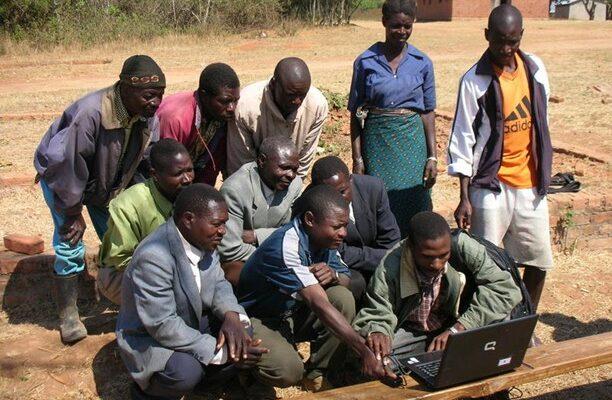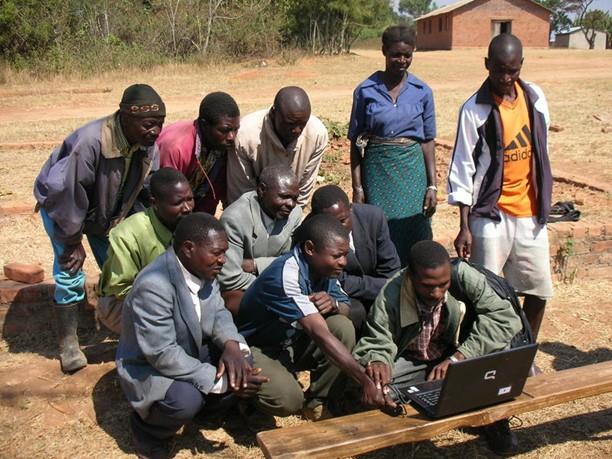
Debating Ideas is a new section that aims to reflect the values and editorial ethos of the African Arguments book series, publishing engaged, often radical, scholarship, original and activist writing from within the African continent and beyond. It will offer debates and engagements, contexts and controversies, and reviews and responses flowing from the African Arguments books.

Farmers gather by a computer demonstrating fingerprint technology. Photo credit: Authors of the study Credit Market Consequences of Improved Personal Identification: Field Experimental Evidence from Malawi
Covid-19 has heightened the need to prove one’s identity with an increased need for the government to target certain relief measures. Vaccination programs and new emergency relief measures, such as digital cash grants, have been rolled out in many countries across the world. Digital identification systems could assist the delivery of these programs by uniquely identifying individuals in the target countries, generating a cleaner and more precise database to administer these relief measures. However, there are also challenges and potential adverse effects of implementing such ID systems, such as the exclusion of vulnerable populations. The question remains: can digital IDs and biometric data collection really revolutionise service delivery in Africa?
In Africa, 15.4 percent of the total population has received at least one dose of their Covid- 19 vaccine, while only 10.2 percent of the total population has been fully vaccinated.[1] Vaccination rollout relies on data systems that are able to distinguish specific individuals and track these individuals over time. These tracking efforts are particularly important in programs that require multiple interactions with beneficiaires (such as multi-dose vaccines) and are critical to ensure that government support—be it a vaccination program or other emergency relief measure—reaches the intended individuals. Digital identification—through digital biometric IDs—could assist with these systems by uniquely identifying individuals in the country and thus generating more precise databases to administer these relief measures. We have seen a number of governments across sub-Saharan Africa express interest in improving their data systems by rolling out new digital biometric identification systems. In 2017, the Government of Malawi registered approximately 9 million adults—cited by implementers as universal coverage—with their own biometric national ID. The Government of Kenya rolled out their digital identity program in 2018 called the Huduma Namba card. This central master population database is said to become the “single source of truth” on a person’s identity in Kenya.
Covid-19 has highlighted the increased importance of identification, however the question still remains: can digital IDs and biometric data collection really revolutionise service delivery in Africa? What are the benefits and challenges of implementing such a system?
The challenges of data access and service delivery
One clear benefit of uniquely identifiable beneficiary data is the ability to determine who is genuinely eligible and who may be a “ghost” or not actually eligible. It is difficult to know exactly why “ghost beneficiaries” may exist in a database. One plausible reason is that paper-based IDs (used to access the service) are difficult to update centrally and duplicates are easily created. If a beneficiary loses their paper-based ID, they could be issued with a new ID and a new number. The individual associated with the lost paper-based ID would be a “ghost” in the system—the service that individual could claim would not be directly associated with a genuine beneficiary, but would still be on the books. Other reasons include more purposeful deception, often with middlemen extracting a share of these benefits. If there are many “ghost beneficiaries” in the data, then removing these duplicate or false entries could decrease the misallocation of resources and increase the total amount spent on actual program outcomes.
A second key benefit of uniquely identifiable data is the ability to link datasets at an individual level over time, which can allow for improved monitoring and feedback systems to governments who are delivering these services. The improved record-keeping and generation of more automated administrative data increases the possibility of identifying areas of improvement of service delivery in a more timely manner. In addition, by linking beneficiary data to other datasets that have more detailed information on household characteristics, such as social registries, governments could improve their ability to identify which specific citizens are most in need of a particular service. Given limited resources, governments may consider how best to use these data to target the delivery of services to specific individuals.
Linking interactions of a beneficiary over time, and the flow of information it generates, may also shape the way individuals behave. For example, J-PAL affiliated researcher Vincent Pons, along with Thomas Bossuroy and Clara Delavallade from the World Bank, evaluated the impact of biometric tracking devices in tuberculosis (TB) care centers in India on patient adherence to treatment, provider performance, and data quality. The biometric tracking changed behaviours, they increased patient adherence to TB treatment and provider performance. Individual changes in behaviour could have an aggregate impact on sectors of the economy, as shown in the following example.
An applied example: using biometric identification to improve information problems in microcredit
In 2006, Muhammad Yunus and the Grameen Bank won the Nobel Peace Prize for pioneering microcredit, elevating its global profile. Since then, the microcredit industry has grown significantly. However, quantitative evidence from low and middle-income countries has shown that traditional microcredit has not led to transformative impacts on income or long-term consumption, on average, due to the modest demand for microcredit products when offered to the general population.
A key challenge in microcredit is the cost of lending, especially in rural or more remote areas. Lenders’ ability to keep costs low and continue extending credit in these environments depends in part on their ability to encourage repayment from borrowers who typically lack adequate collateral or verifiable credit histories. Lenders may use certain incentives, such as the threat of future credit denial, to elicit on-time repayment and lower costs. However, these incentives only work when borrowers can be consistently identified. If lenders are not able to identify individual borrowers and track their repayment histories, they may be unwilling to offer credit, as they do not know who will or will not repay their loans.
Prior to the 2017 national ID rollout in Malawi, it was difficult to link the identity of a farmer with his or her credit record: banks issuing loans to farmers often were unable to verify who the farmer was and whether the farmer had repaid their prior loans. It was therefore possible for a farmer to take out a loan, not repay it, and still manage to take out a new loan from the same lender in the following year by using a different name.
Biometric identification (using fingerprints) presented a possible solution for this challenge in the microcredit industry. J-PAL affiliated researchers Dean Yang and Jessica Goldberg, together with Xavier Giné from the World Bank, used a randomized evaluation to assess the impact of collecting farmers’ fingerprints on loan repayment. In this study, farmers were randomly assigned into one of two groups: either a group where their fingerprints were collected or a group where they were not.

The researchers found that fingerprinting improved loan repayment, particularly for borrowers expected to have the poorest repayment performance. Repayment performance was based on a “predicted repayment” measure the researchers constructed from individual characteristics in the baseline survey. Fingerprinting induced the riskiest borrowers to repay their loans at almost the same rate at the least risky borrowers. Conservative estimates of benefits and costs demonstrated how using biometric technology to identify borrowers had a high rate of return for the lender.
This study demonstrates how biometrics, such as fingerprints, can shift client repayment behaviour and therefore improve credit market efficiency at a small scale. If challenges in identifying borrowers deter lenders from offering credit, fingerprinting techniques could potentially reduce one of the barriers of providing credit in rural areas. Working with large digital systems brings an additional host of challenges. What are the associated risks with digital IDs and uniquely identifiable data at scale? How can systems be designed to mitigate these risks?
Challenges of implementing digital IDs and uniquely identifiable data in sub-Saharan Africa
Implementation challenges can be a problem when digital IDs, and the associated uniquely identifiable data, are scaled across a country. A larger roll out of the program in Malawi was attempted to understand whether the positive fingerprinting findings of the original study would be sustained when the program was scaled. Unfortunately, infrastructure difficulties such as poor data coverage, power outages, challenges in the use of the interface, and low participation in the credit bureaus posed barriers to successful implementation at scale. Despite providing technical solutions or work-arounds to these issues, the researchers saw relatively low adoption of fingerprint identification by local micro-finance institutions. These challenges highlight how difficult it can be to scale a complicated technology in a resource-constrained setting, and also indicates the importance of building identification into the data and operational systems of these programs, rather than treating it as an add-on or distinct and separate function.
Another challenge with digital IDs and uniquely identifiable data is that while the process of removing “ghost” beneficiaries (as described above) could help with reducing leakages within service delivery, it could also exacerbate a different problem. Eliminating duplicate data in a database may be at the cost of excluding legitimate beneficiaries: individuals who are eligible but who were unable to pass the biometric authentication test. This often includes vulnerable groups, such as the elderly and manual workers, or those who were not able to link their ID number and biometrics to their service delivery account.
For example, in India, J-PAL Affiliated researchers Karthik Muralidharan, Paul Niehaus and Sandip Sukhtankar, found that the Aadhaar-based biometric authentication and reconciliation of beneficiaries in their public food distribution programme led to a fall in corruption, but with substantial costs to legitimate beneficiaries. They estimated 1.5 to 2 million eligible beneficiaries lost access to benefits at some point during the reforms. Exclusion was concentrated among those who had not linked their ration cards, as there was no effective manual override option. Digital IDs, and the data they collect, can also generate pushback from the public. Biometric data collection, such as fingerprints and iris scans, raises important privacy and data misuse concerns. Kenya experienced major pushback to digital IDs from a number of groups including the Nubian Rights Forum, an NGO that supports members of the historically-marginalised Nubian community. The main concerns raised are associated with the embedded risks in the system, such as the exclusion of certain groups, discrimination, and data breaches.
Measuring impacts of digital IDs and uniquely identifiable data
Covid-19 has highlighted the increased importance for clear identification, with particular need in the multi-dose vaccination program or other emergency relief measures. However there are both benefits and challenges of implementing such a system. Digital identification could assist with these systems by uniquely identifying individuals, generating a cleaner and more precise database of eligible program beneficiaries. As highlighted in the Malawi fingerprinting example, the details collected through these databases could unlock important barriers to serving isolated beneficiaries, in this case by decreasing information gaps in the credit market. While these initial findings are promising in theory, understanding context- specific implementation, scale, and timing challenges is incredibly important to ensure the effective implementation of the technology behind the uniquely identifiable data.
Questions still remain if digital IDs and biometric data collection can really revolutionise service delivery in Africa. There is a lack of rigorous evidence on how to best design these systems, the implications of these large systems, and how they affect people on the ground. In the spirit of building out this evidence base, the benefits and risks should be accurately measured as new identity systems are rolled out. Collecting the evidence and evaluating the impacts will be critical to both keep governments accountable and ensure systems are building towards a better post-pandemic world for all.
End Note
[1] These data are cited based on estimates from Our World in Data on 23 January 2022.





